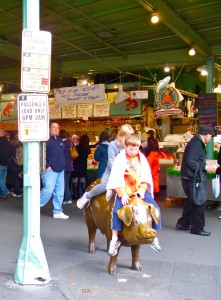
Want access to a lively community of writers and readers, free writing classes, co-working sessions, special speakers, weekly writing games, random pictures and MORE for as little as $2? Check out Cat’s Patreon campaign.

"(On the writing F&SF workshop) Wanted to crow and say thanks: the first story I wrote after taking your class was my very first sale. Coincidence? nah….thanks so much."

What makes Seattle particularly well suited to writing speculative fiction set in it?
Kat – Marvelously creepy weather, and distinct neighborhoods that preserve their history. What are ghosts but history that won’t go away?
Julie – The weather for sure, as well as the visual landscape it provides. The distinct neighborhoods with life. Any fiction set in a distinct city is better.
John – The diversity of culture and people as well as the landscape
K.C. – The geography and the weather, which can go from fog to crystal clear one day to the next.
What landmarks of Seattle lend themselves to spec-fic writing?
Kat – Pioneer Square. The first year I was here, an unusual fog struck and all I could see were the disembodied feet of pedestrians moving in it, which inspired all sorts of possibilities writing-wise. Seattle has lots of layers, which are great writing points, the places where the skeleton is partially exposed.
Julie – Seattle has lots of distinctive features. The Greenlake district is really distinctive, but there are lots of different settings that are suited to different moods.
John – The greenness of winter as well as the wilderness and the places to get lost that it provides
K.C. – The whimsical details of the city, such as the five foot concrete dragon in the park near me in West Seattle. I wrote my story, I Must to the Barber’s Chair, because of a sign I’d seen: “Psychic” in one window and “Barber” in the adjoining one. After the story was published, the barber who owned that shop wrote to me. He said the psychic had gone out of business (which you think they would have seen coming) and he’d been moved to buy the “Psychic” sign and add it to his own window.
How do you research Seattle-based stories?
Kat recommends Historylink.org, which has its own Twitter stream, as a resource.
Also the Museum of History and Industry.
Most participants like to go to places to research and get the ambience that affects a story.
K.C. believes in fussing with setting details, while John suggests fussing on a different level by researching names and cultural background. He strives for enough concrete details to make something authentic then makes up the rest, creating a veneer of research that doesn’t bog him down.
Kat: I’d like to be right all the time but the city keeps changing, like the Picnic Pavilion in Occidental Park, which got torn down after the book holding it was published.
Cat suggests one of the Seattle ghost tours, and recently did this one. Learned details like a place at Pike Place Market where three ley lines meet, and Dr. Linda Hazard, an early Seattle serial killer.
Details of Seattle that make it particularly well suited to the weird:
High number of serial killers
Lots of wildlife – cougars and bears
Fertility of the soil
Banana slugs and geoducks
...

As far as selling goes, the first day was not particularly successful and on that day 50% of the book sold were to each other. The second day was more of the same, although we didn’t sell as many to each other. Overall, doing a group thing was definitely a good idea: it made for a table packed with attractive, professionally done books along with some table display stuff like a robot, a war-elephant, and some fantasy stuffed animals (including plushie Chtulhu). It also meant we had people to chat with and the livelier appearance of our table helped pull people in, I think. (Plus we had candy.) We might have done better on the first floor than the second, and there were some lighting issues.
I presented a workshop on podcasting, which was well attended, and I ran them through some whys and whats of recording your own podcast as well as ranting a bit about rights and not paying to publish. A number of them signed up to get advance notice of the Building an Online Presence for Writers book.
Overall, it was fun, and there was some decent networking, plus I passed out some postcards on my classes. On the other hand, did we sell many books? Not at all. However, the cost of the $100 table, split between all of us, was pretty darn reasonable, and it meant we could attend workshops. We didn’t have a formal name, so I’d put “Seattle Speculative Fiction Writers” down. So many people asked about our group the first day that Django ended up putting out a sign-up sheet for news of group activities and gathering two pages of e-mail addresses. I look forward to the first wine and chat party.
If I ran an effort like this again, I’d focus more on selling: perhaps do book bundles, make a sign letting people know the books were priced at special rates for the book festival, maybe have some lower-priced items or stocking-stuffer type trinkets, and would have a signup sheet for other mailing lists, like each author’s. However, the location was so difficult to get to that there was no foot traffic and some people had difficulty finding the place — if they do it in the same location next year, I’ll pass and spend that time writing instead, but as Brenda noted, if they move it back downtown, it might be worthwhile.
...